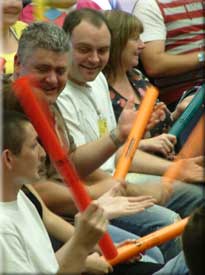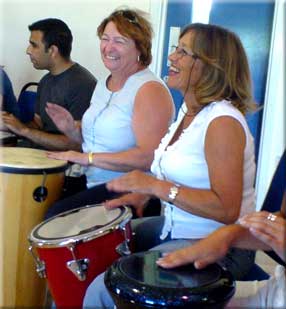ACTIVE RHYTHMOLOGY
Playing Techniques - Bass Tone Slap

If your heart is beating you are ready to be...rhythmologised !
Here we provide a basic knowledge of different playing techniques for the variety of instruments we use for group drumming activities...
Our workshops and our other rhythm activities are designed to fully cover the basic techniques through fun rhythm games and more. This allows complete beginners and experienced musicians to play the instruments correctly so they can enjoy themselves and make up rhythms together within minutes... often straight away!
However, if you would like a head start, or just want to learn and practice at home, here are some simple hand drumming, body percussion, rhythmical vocal and junk percussion techniques and tips to get you improvising grooves and enjoying yourself quickly and easily!
Bass - Tone - Slap
How to get 3 different sounds from a hand drum...
Bass, tone and slap are the three main strokes used to play most large hand drums.
The bass is played by bouncing the centre of the open and relaxed palm in the centre of the drum. Unless the drum has feet it needs to be tilted slightly to let the deep bass sound resonate out of the hole at the bottom of the drum.
The tone produces a sharper, higher pitched sound and is played by striking the edge of the drum head with the fingers. It is a quick motion to lift the sound up and out of the drum head.
The slap produces a loud crack and is played by striking the palm on the edge of the drum and allowing the fingers to move forwards like whips to hit the drum head at high speed. This stroke can take a while to master and although it is great for adding accents to the rhythms, the slap is not essential - a missed slap usually comes out like a tone anyway.
All three strokes - bass, tone and slap - are normally played with the drum head open, that is with the other hand clear of the drum head. The hand strikes the drum and then lifts off immediately so that the drum head can vibrate to produce the bass, tone or slap sound. It is usually easier to alternate hands with each stroke while playing.
Remember to keep your thumb out of the way of the rim of the drum and stay relaxed to avoid injury. If something feels uncomfortable then adjust your actions accordingly to make sure you have fun without hurting yourself!
Have a look at one of our drumming workshop videos here
Vocals and Body PercussionThe human body is a fantastically versatile instrument! You can create many, many different sounds using 'body percussion' by clicking your fingers, clapping your hands in different ways, beating your chest, slapping your thighs, stamping your feet and whatever else you can think of. If it sounds good and doesn't hurt - keep doing it! It's easy to come up with rhythmical vocal chants during your every day life to use for group participation, or just to keep you entertained! You can hear Steve using a chant to start off a groove at a team building drum circle towards the end of this video. Human beatboxing is another fun rhythmical technique you can experiment with to make realistic drum, synthesiser and other instrument sound effects with your mouth. A great way to learn a basic human beatbox drum beat with bass drum, snare and hi-hat sounds is to practice saying the phrase "bouncing cats" repeatedly. Gradually emphasise the start of all 3 syllables as you practice: "boun" gives a bass drum sound effect, "cing" should eventually sound like hi-hat cymbals and "cats" should give you a good snare drum sound. To complete the 4 beat cycle repeat the phrase twice. You can emphasise and slightly prolong the "ts" at the end of "cats" to give another hi-hat sound effect... If you could write down the sounds you should be producing after practicing the phrase "bouncing cats, bouncing cats" - it will eventually be something like: "boom tsss cat tsss boom tsss cat tsss" etc. You can also alternate saying "bouncing cats" with the phrase "baboons and cats" which gives a double bass drum beat sound. Once you have mastered these sounds, you can experiment with different patterns and other sound effects - just make it up! The great thing about beatboxing is that you can do it anywhere without having to carry a 5 piece drum kit, cymbals and hardware around with you!
|
 |
Boomwhackers
Boomwhacker tuned percussion tubes are hollow plastic tubes of specific lengths to give different notes. These are also represented by the corresponding bright colours of the tubes. Playing Boomwhackers is easy! All you do is hold one end of the tube and hit the other end about 1/4 of the way down on the palm of your hand. Hitting your palm or your fingers allows you to play at different volumes. If your hand gets sore, then you can simply swap hands, or hit something else such as your knee or shoe. We sell Boomwhackers in multiples of 6 (a full pentatonic set). If you would like to purchase any quantity just let us know by email or phone. |
| Improvising rhythms with Boomwhackers sound most impressive in larger groups. We can provide a Boomwhacker rhythm activity for any number of participants from about 50 up to hundreds or even thousands! Ideal for team building conference energisers, private parties, wedding evening receptions and more! Just contact us to discuss your requirements if you are interested in a massed Boomwhacker activity. You can also use the Boomwhackers tuned specific notes to play melodies if you have a lot of hands, or a few friends to play along with you! Junk PercussionUsing waste containers etc. as drums and percussion instruments is a great way to help the environment by recycling and save money at the same time! Instead of forking out hundreds on an expensive hand drum why not try out some empty plastic tubs first? You'll be surprised how good some things sound that you have lying around your house or garage! You can use similar hand drumming techniques as taught at the top of this page to play the bottom of plastic containers and tubs, or use beaters and sticks. Bass drum beaters can be made cheaply from sticks of dowel with a piece of rubber or foam pipe insulation taped around the end and cloth secured around it. For smaller tubs, bottles and metal found-sounds try using plastic chopsticks. Here are some great sounding easily available junk percussion instruments and ideas to play them:
If you've got percussionitis and can't stop yourself from tapping and drumming away on surfaces where ever you are, like we do too often, then you're sure to discover some great sounding junk percussion items. Just remember to wash them thoroughly, remove any sharp edges and make them safe before use! We have a wide mixture of safe junk percussion instruments that we use to facilitate group rhythm events for up to 200 participants. Just email or phone us to book a low budget junk percussion activity for your event!
We hope you have fun experimenting with these different rhythm making techniques. Please get in touch if you would like us to lead a workshop or group rhythm activity to help guests at your event have fun making music in one or more of these ways! Now you have discovered how fun and easy rhythm making can be contact us to provide a rhythm activity at your next event...For more videos, photos and our latest updates please Like our Facebook Page: Corporate DrummingActive Drumming Home | Active Drumming Rhythm Activity Videos | Contact Active Drumming | Leeds Team Building Rhythm Activities | About Active Drumming | Business - Corporate Team Building Drumming | Education - School Drumming Workshops | Health - Relax, Reduce Stress and Have Fun Drumming | Community - Building Community Through Rhythm | Parties - Drum Circle Celebrations | Activities - Active Drumming Services | Bass - Tone - Slap - Drum Playing Techniques | Feedback - Previous Client's Testimonials | Links - Active Drumming's Useful Link Resources | Additional Link Resources - Link Trade Copyright © 2011 Active Rhythmology |


